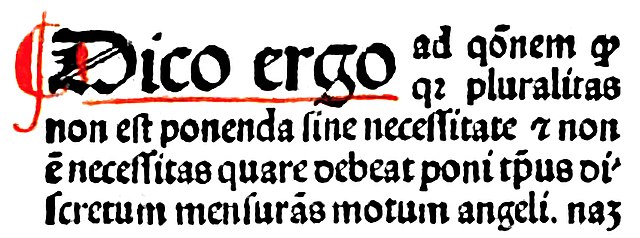In philosophy, Occam's razor is the problem-solving principle that recommends searching for explanations constructed with the smallest possible set of elements. It is also known as the principle of parsimony or the law of parsimony. Attributed to William of Ockham, a 14th-century English philosopher and theologian, it is frequently cited as Entia non sunt multiplicanda praeter necessitatem, which translates as "Entities must not be multiplied beyond necessity", although Occam never used these exact words. Popularly, the principle is sometimes paraphrased as "The simplest explanation is usually the best one."
Part of a page from John Duns Scotus's book Commentaria oxoniensia ad IV libros magistri Sententiarus, showing the words: "Pluralitas non est ponenda sine necessitate", i.e., "Plurality is not to be posited without necessity"
Manuscript illustration of William of Ockham
Possible explanations can become needlessly complex. It might be coherent, for instance, to add the involvement of leprechauns to any explanation, but Occam's razor would prevent such additions unless they were necessary.
Andreas Cellarius's illustration of the Copernican system, from the Harmonia Macrocosmica (1660). Future positions of the sun, moon and other solar system bodies can be calculated using a geocentric model (the earth is at the centre) or using a heliocentric model (the sun is at the centre). Both work, but the geocentric model arrives at the same conclusions through a much more complex system of calculations than the heliocentric model. This was pointed out in a preface to
William of Ockham or Occam was an English Franciscan friar, scholastic philosopher, apologist, and Catholic theologian, who is believed to have been born in Ockham, a small village in Surrey. He is considered to be one of the major figures of medieval thought and was at the centre of the major intellectual and political controversies of the 14th century. He is commonly known for Occam's razor, the methodological principle that bears his name, and also produced significant works on logic, physics and theology. William is remembered in the Church of England with a commemoration on the 10th of April.
Depiction of William of Ockham
Sketch labelled "frater Occham iste", from a manuscript of Ockham's Summa Logicae, 1341
Quaestiones in quattuor libros sententiarum






